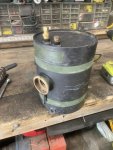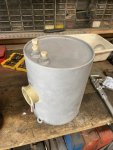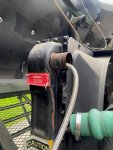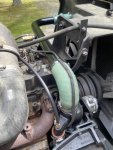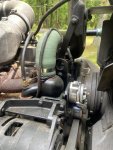- 8,698
- 3,204
- 113
- Location
- Monrovia, Ca.
Brands/types. If you got at NAPA, get them from NAPA
Steel Soldiers now has a few new forums, read more about it at: New Munitions Forums!

I have to replace a leaking thermostat-housing gasket and noticed the coolant is still rusty / coffee-like so I think it's good to do another system flush on top of this. To do this with white vinegar as suggested, since it is a mild acid, how many gallons to add to the system? How long should it sit in the system before draining out?If you’ve got lots of rust & scale then flush with white vinegar.

Personally I'm not a fan of vinegar in coolant flushes. I've seen it perform no better than a couple passes of water at best, and cause leaks at worst. When I flushed mine, I bought like 50 gallons of distilled water and ran that all thru until it was draining clear. There probably was a more time-effective way of doing it. I was just extra paranoid about the whole ELC / SCA / eating head gaskets / liner cavitation debate, I wanted to add as few different new chemicals as possible.To do this with white vinegar as suggested, since it is a mild acid, how many gallons to add to the system? How long should it sit in the system before draining out?
For flushing purposes this would be totally fine. It'll actually save a lot of time on drains/refills because you *wont* have to wait for the water to warm up to open the thermostat to circulate thru the whole system (since there is no thermostat to open, obvs). I did this exact thing with my GMC a few years agoDo you think I could reinstall the t-stat housing (temporarily) without the t-stat installed to get everything from the block moving around? Doing the flushing procedure without the t-stat in place?
Yes Sir I ordered the T-Stat with new seal as well, probably original part in there it's time to come out if opened up I say lol. That's great about the diverter-plug I actually didn't know what that was for but now it makes total sense, thank you!You should also replace #26, the seal. If it is compromised you will have slow warm up and low running temps. It basically bypasses the stat if it is junk. And, with an auto trans, that could be a bad thing because there should be a diverter plug installed so that when the stat is closed, there is positive coolant flow through the trans cooler. With the seal failed, you will have very low coolant temp and below "optimal" trans oil temp.
That's a good copy, how much per gallon / the system for the flush? How long should it sit in there before draining out? I guess I'm paranoid about clogging up lines with all the rust it will remove lol.Use phosphoric acid to flush. It's safer for the engine. You can purchase it as concrete and metal etch at your local hardware store.
Good to hear on this, I know most of the "material" settles so getting it out of the block quicker will help. I'll do the drain and flushes with the t-stat removed, and then do a final install on the new gaskets / seal / T-stat before adding last round of distilled water and coolant-concentrate.For flushing purposes this would be totally fine. It'll actually save a lot of time on drains/refills because you *wont* have to wait for the water to warm up to open the thermostat to circulate thru the whole system (since there is no thermostat to open, obvs). I did this exact thing with my GMC a few years ago
thats a good little setup. i really should do something like that with my A1Also since I mentioned it previously, here are some pix of the coolant-filter I installed
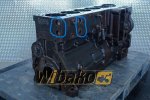
Ty Sir, the filter does get really hot so I know I have (decent) flow through it lol. The port on this filter-base is much wider than the (Napa?) one that a lof of guys use, and I liked how it was multi-directional instead of having to feed in from the top only. I wound up just using the hoses that were already there but I do have a parts list of where I bought from if you're interested.thats a good little setup. i really should do something like that with my A1
Honestly I'm not sure what you're getting at, are you saying there is stand-alone corrosion inhibitor systems you can hook up to the engine?There are provisions on the C for corrosion inhibitor installations. Two spots. The exhaust side has 2, soft plugs, these go into the lower and upper coolant cavities. Lower is high pressure, high is low pressure and rear of the block, same configuration.
